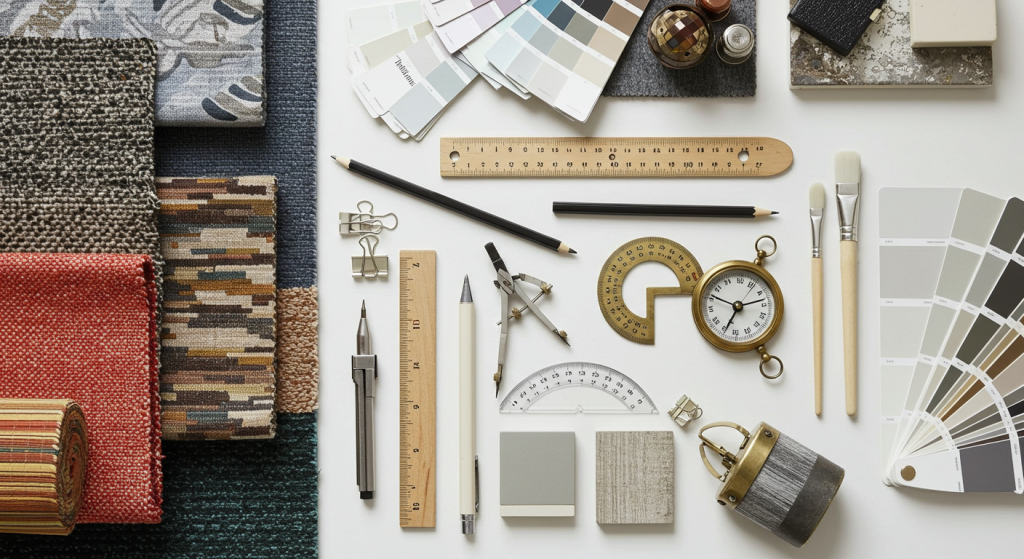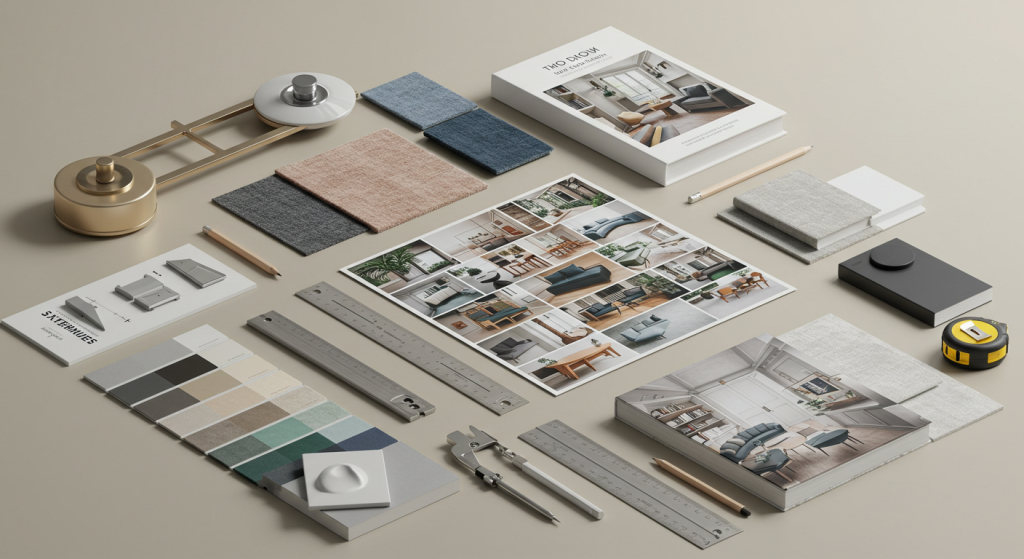This post may contains affiliate links. Read our full disclosure here.
Scrolling through job listings and debating career paths can leave your head spinning with numbers. That’s especially true if you’ve got your eye on interior design. The interior designer salary range can vary dramatically depending on so many factors! After working in both wine and home decor industries, I’ve chatted with countless designer friends about what they actually make versus what they expected to earn. Let’s cut through the noise and get real about what interior designers can expect to earn in 2025.
Whether you’re considering a career switch, fresh out of design school, or looking to level up your existing interior design career, understanding salary expectations is crucial for planning your future. The interior designer salary landscape in 2025 looks different than even a few years ago, with new specialties emerging and remote work changing how companies hire and pay. I’m breaking down the real numbers beyond the glossy Instagram portfolios!

What’s the Average Interior Designer Salary in 2025?
Let’s talk actual numbers. The average interior designer salary in 2025 falls between $50,000 and $90,000 annually. That’s quite a range, right? Your specific earnings will depend on several key factors that I’ve seen make huge differences in my friends’ paychecks across the industry.
Experience level plays a massive role in what you’ll earn. Entry-level designers (those with 0-3 years of experience) typically make between $45,000-$60,000. Once you hit that mid-career sweet spot (4-7 years), you’re looking at $60,000-$80,000. And those seasoned pros with 8+ years under their belts? They can command $80,000-$110,000+ annually, especially if they’ve built a strong reputation or launched their design career with a specific niche.
Your specialty focus dramatically impacts your earning potential in the interior design world. Residential designers working with average homeowners typically earn less than those working in commercial spaces or high-end luxury homes.
- Key salary influencers include:
- Years of professional experience
- Geographic location and market demand
- Design specialty and industry focus
- Employment type (freelance vs. agency vs. in-house)
- Portfolio quality and professional network

How Location Affects Your Interior Designer Salary
Location, location, location! It’s not just important for real estate—it dramatically impacts your interior designer salary too. Working in high-cost, design-forward cities like New York, San Francisco, or Los Angeles typically means higher earning potential but also higher living expenses. In NYC, interior designers typically earn between $70,000-$120,000, while San Francisco designers see similar ranges at $68,000-$110,000.

Mid-tier markets like Atlanta, Dallas, and Denver offer decent salaries ($55,000-$85,000) with more reasonable living costs. When I lived in an apartment during college, my designer friend in Chicago made nearly double what her equally talented friend earned in a small Midwest town.
Smaller markets and rural areas generally offer lower salaries ($40,000-$65,000) due to less demand and lower project budgets. However, the rise of remote work is changing this dynamic. Many designers now live in affordable areas while working for clients in major cities, getting the best of both worlds!
- Regional salary insights:
- West Coast cities typically offer 15-25% higher salaries
- Southern states generally pay less but offer lower cost of living
- Tourist destinations often have seasonal design work with premium rates
- Remote work opportunities can help balance regional pay differences
- International design hubs like London and Dubai offer premium salaries for experienced designers

Freelance vs. Full-Time Interior Designer Salary Differences
The freelance versus full-time debate is huge in interior design circles! As someone who’s watched friends navigate both paths, I can tell you each has distinct financial pros and cons. Freelance interior designers in 2025 typically charge between $50-$150+ per hour depending on experience and location, or they may set project-based fees that range from a few thousand to tens of thousands of dollars.
Full-time designers earn more predictable paychecks, typically with benefits like health insurance, paid time off, and retirement plans that have significant value. My boyfriend’s sister works at a design firm and loves the stability, even though her freelance friends occasionally brag about five-figure months.
The catch? Freelancers need to account for unpaid time spent marketing, invoicing, and managing business operations. They also cover their own taxes, insurance, and retirement planning. Plus, income can fluctuate drastically between busy and slow seasons. If you’re curious about finding more stable design opportunities, check out how to find interior design jobs in 2025 for the latest strategies.
- Consider freelancing if:
- You have an established portfolio to attract clients
- You’re comfortable with financial ups and downs
- You enjoy the business side of design (marketing, client relations, bookkeeping)
- You value schedule flexibility over predictability
- You have savings to cover slow periods
Design Specializations That Boost Your Earning Potential
Not all design paths lead to the same paycheck! Certain specializations can significantly increase your interior designer salary in 2025. Commercial and hospitality design (offices, hotels, restaurants) typically pays between $65,000-$100,000+ annually because these projects have larger budgets and more complex requirements than typical residential jobs.

Healthcare design and sustainable/green design are growing niches commanding premium rates ($60,000-$95,000) due to specialized knowledge requirements and increasing demand. One of my former colleagues switched from residential to healthcare design and saw her salary jump by almost 30% within a year!
Luxury residential design for high-net-worth clients can be extremely lucrative ($70,000-$120,000+) but often requires an established reputation and connections in wealthy communities. Many designers start with more modest projects while building toward this specialty. Creating the perfect productive home office environment has become another specialized niche with growing demand.
E-design and virtual design services represent newer pathways with flexible earning potential. These services typically charge lower rates but allow designers to take on more clients simultaneously, potentially increasing overall income.
- Certification boosts for your salary:
- NCIDQ certification can increase salary by 10-15%
- LEED accreditation adds value for sustainable design roles
- CAD/3D rendering specialization commands higher rates
- Project management certifications justify higher fees
- Specialized training in universal/accessible design is increasingly valuable
Smart Strategies to Maximize Your Interior Designer Salary in 2025
Want to hit the higher end of the interior designer salary range? Strategic career moves make all the difference! I’ve watched friends transform their earning potential with some clever approaches. Building a distinctive portfolio that showcases your unique style while demonstrating versatility is essential. Potential clients and employers pay premium rates for designers who bring fresh perspectives rather than following trends.

Developing business skills alongside design talent dramatically increases income potential. Understanding project management, client psychology, and basic accounting principles helps you manage larger projects efficiently and price your services confidently. Learning to curate spaces with intentional style can help your portfolio stand out from the crowd.
Networking strategically within design circles and adjacent industries (real estate, construction, home staging) creates referral pipelines that reduce marketing costs and bring higher-quality clients. One friend gets almost all her business from two real estate agents who love her work!
- Salary-boosting side hustles:
- Creating digital design products (templates, guides, planners)
- Teaching design workshops or online courses
- Consulting on color strategies for paint companies
- Writing design content for blogs and magazines
- Participating in sponsored social media content for home brands
Staying on top of design trends is crucial for commanding top rates. Regularly updating your skills with the latest home decor trends ensures you’re offering current value to clients. The most successful designers I know are constantly learning—whether it’s new software, materials knowledge, or sustainable practices.
Remember that salary negotiations aren’t just for full-time positions. Freelancers should regularly review and adjust their rates based on experience gained and market conditions. Many designers undercharge simply because they haven’t reassessed their worth in years!
Realistic Expectations for Your Design Career Journey
I’ve seen too many talented designers get discouraged because they expected overnight success and six-figure salaries right out of the gate. The truth? Building a lucrative design career takes time. Your first interior designer salary will likely be modest, but consistent growth comes with strategic experience building.

Early career moves matter tremendously. Working for a respected firm, even at a lower initial salary, can provide training and connections that accelerate your earning trajectory later. Several designer friends who “paid their dues” at established firms were able to launch successful independent practices within 3-5 years.
The interior design industry continues to evolve rapidly. Emerging technologies like AR/VR visualization, sustainability requirements, and changing work/home environments create new specialization opportunities. Designers who position themselves at the forefront of these changes often command premium salaries.
Your interior designer salary in 2025 reflects more than just your design talents—it represents your business acumen, professional relationships, specialized knowledge, and reputation. By focusing on building these aspects alongside your portfolio, you’ll create a solid foundation for financial success in this creative field. Whether you’re dreaming of designing luxury homes, transforming commercial spaces, or creating boutique hospitality experiences, understanding the financial landscape helps you chart a realistic path forward while keeping your creative passion alive!




